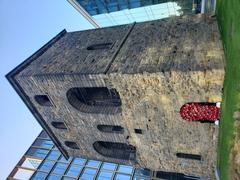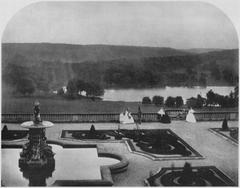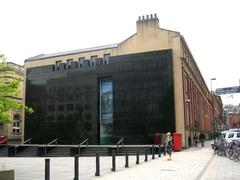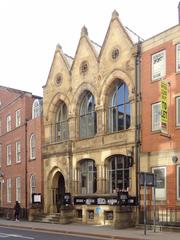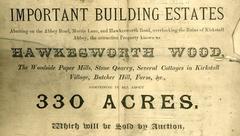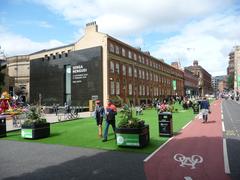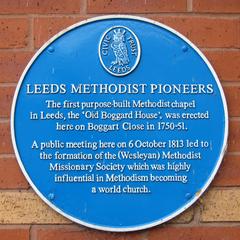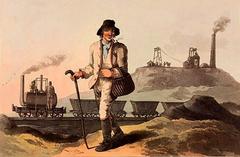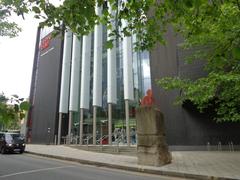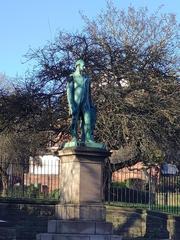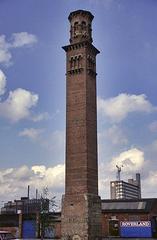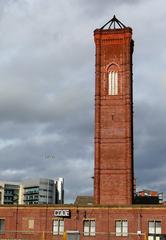Leeds Industrial Museum: Ultimate Visitor Guide
Date: 04/07/2025
Introduction
Leeds Industrial Museum at Armley Mills stands as an enduring monument to the city’s industrial revolution, offering an immersive exploration of Leeds’ legacy in textiles, engineering, and innovation. Set on the historic Armley Mills site, with origins dating back to the mid-16th century, the museum preserves the story of what was once the world’s largest woollen mill. Visitors encounter everything from monumental spinning mules and steam engines to the 1920s Palace Picture House—one of the smallest working cinemas globally. This guide details the museum’s history, collections, exhibitions, special events, practical visitor information, and top travel tips, ensuring a seamless and enriching experience for families, history enthusiasts, and educational groups (Leeds Museums & Galleries; Discover Leeds; Leeds City Magazine).
Table of Contents
- History and Significance
- Permanent Collections & Core Galleries
- Special Exhibitions & Events
- Visitor Information
- Visiting Tips & FAQs
- Conclusion
- References & Official Links
History and Significance
Origins and Early Development
Armley Mills has a documented history from the 1550s, when clothier Richard Booth leased the property from Henry Saville to begin textile production (leeds-uk.com). By 1707, it had evolved into a fulling mill complex, powered by the River Aire and later the Leeds and Liverpool Canal, which made transportation of goods efficient and fueled industrial expansion (Discover Leeds).
A devastating fire in 1804 led to reconstruction under Benjamin Gott, a leading industrialist, who designed the mill’s current stone structures in 1805 (wikipedia). These buildings are now Grade II* listed for their architectural and historical importance.
Industrial Impact
Textiles: Leeds became a global powerhouse in wool production, and Armley Mills was at the heart of this transformation. The mill specialized in carding, spinning, and weaving wool, processes still demonstrated in the museum’s textile galleries today (museumsandgalleries.leeds.gov.uk).
Engineering & Transport: The city’s engineering reputation is reflected in exhibits on local innovators like John Smeaton and John Fowler, plus memorabilia from Leeds locomotive manufacturers such as Hunslet Engine Co. and Kitson (nationalarchives.gov.uk).
Printing, Film & Media: The museum’s media galleries showcase Leeds’ role in printing technology and early film, with displays of historic presses and the atmospheric Palace Picture House (visitleeds.co.uk).
Social History
At its peak, Armley Mills employed hundreds of workers, many living in nearby Victorian cottages. The museum’s recreated cottages and Manager’s House, along with oral histories and photographs, give insight into daily life during Leeds’ industrial boom (douk.com).
Museum Transition
After the mill’s closure in 1969, Leeds City Council acquired and reopened it as Leeds Industrial Museum in 1982, preserving machinery, documents, and stories vital to understanding Britain’s industrial heritage (wikipedia).
Permanent Collections & Core Galleries
Textile Machinery and Woollen Industry
The Textile Galleries feature operational spinning mules, carding engines, and looms, including an 1871 spinning mule (the oldest surviving) and a 1904 model still used in demonstrations (Leeds Museums & Galleries). Interactive panels explain processes from carding to dyeing, complemented by the Colour Garden, which grows traditional dye plants.
Engineering and Heavy Industry
The Powerhouse Gallery contains steam engines (some live on Steam Days), tools, and products from major Leeds firms like Vickers PLC and Kirkstall Forge, illustrating the city’s breadth of industrial expertise (Leeds Museums & Galleries).
Railway and Transport Heritage
Transport exhibits highlight the Middleton Railway, the world’s oldest continuously operating railway, with original rails and memorabilia (Leeds Museums & Galleries).
Early Cinema: The Palace Picture House
This 1920s cinema, with just 24 seats, is among the world’s smallest. It screens historic films and houses an impressive collection of projectors and cameras (Discover Leeds).
Tailoring and Social History
The Tailoring Gallery explores Leeds’ role in ready-to-wear fashion, displaying garments, tools, and advertising materials. The Manager’s Cottage and social history exhibits reconstruct the lives of mill workers and their families (Leeds Museums & Galleries).
Special Exhibitions & Events
“Entangled” – Industry and the Environment
Running until May 2025, “Entangled” features textile art from 25 artists, including local felt artist Janine Jacques, exploring the intersection of industry and nature through the medium of felt (Leeds Inspired; Towpath Talk).
The Salamanca Model Locomotive
This exhibition features a replica of Matthew Murray’s 1811 Salamanca, the world’s first commercially successful steam locomotive, with stories of its operation and significance in rail history (Leeds City Magazine).
Woolfest: Celebrating Textile Heritage
Woolfest is an annual celebration with craft stalls, live demonstrations, talks, and workshops. The 2025 event is on Saturday, 31 May (adults £5, children £2.90) (Leeds Star; Visit Leeds).
Community Events & Educational Activities
The museum’s calendar includes craft markets, family-friendly workshops, “Sparky Saturdays,” and curriculum-linked sessions for school groups (Educational Visits UK). Heritage Open Days and Leeds Waterfront Festival feature expanded programming for all ages (Days Out Yorkshire).
Visitor Information
Location & Getting There
- Address: Armley Mills, Canal Road, Leeds, LS12 2QF
- By Bus: Routes 16 and 16A from Leeds city centre stop near the museum.
- By Train: Leeds station is about 2 miles away; take a bus, taxi, or walk along the canal.
- Parking: Free on-site parking, but spaces may be limited during busy periods (Creative Tourist).
Visiting Hours
- General: Tuesday–Sunday, 10am–5pm (last admission 4:30pm).
- Closed: Mondays (except Bank Holidays) and some public holidays.
- Check for updates: Official website.
Tickets & Admission
- General Admission:
- Free for residents of LS3, LS4, LS5, and LS12 (with proof of address).
- Standard admission fees for others; discounted rates for children, students, seniors, and families.
- Special events (e.g., Woolfest) may require additional tickets (Leeds Museums & Galleries).
Facilities & Accessibility
- Restrooms: Accessible toilets available.
- Shop: Souvenirs, books, and snacks.
- Picnic Areas: Canalside seating and the Colour Garden.
- Accessibility: Step-free access to most ground floor galleries. Some historic areas may be challenging; staff are available to assist. Guide dogs welcome (Leeds Museums & Galleries).
Visiting Tips & FAQs
Top Tips
- Plan for 2–3 hours: To enjoy all galleries, demonstrations, and gardens.
- Visit on Steam Days: Experience live steam engine demonstrations.
- Check the events calendar: For workshops, tours, and family activities.
- Dress comfortably: The historic mill can be cool and floors uneven.
- Combine your visit: With Kirkstall Abbey, Leeds City Museum, or Royal Armouries (WhichMuseum).
Frequently Asked Questions
Q: What are the visiting hours?
A: Tuesday–Sunday, 10am–5pm (last entry 4:30pm). Closed Mondays and some holidays.
Q: How much is admission?
A: Free for local residents (LS3, LS4, LS5, LS12); standard fees for others; special event fees may apply.
Q: Is the museum wheelchair accessible?
A: Most areas are step-free; some older areas may be less accessible. Assistance is available.
Q: Can I take photographs?
A: Yes, for personal use. Flash and tripods may be restricted.
Q: Are guided tours available?
A: Yes, during special events and by arrangement. Check What’s On.
Q: Can I buy tickets online?
A: General admission is on-site only; special events may be booked online.
Conclusion
Leeds Industrial Museum is a vibrant celebration of the city’s industrial legacy, offering rich collections, live demonstrations, family activities, and dynamic special exhibitions. Its riverside setting and accessible facilities make it an inviting destination for all. With its blend of historical depth and contemporary programming, the museum is a must-visit for anyone interested in Britain’s industrial past or seeking a memorable day out in Leeds.
For the latest information on opening hours, ticketing, and events, visit the official Leeds Industrial Museum website, follow the museum on social media, and consider downloading the Audiala app for digital guides and event updates.
References & Official Links
- Leeds Museums & Galleries – Exhibitions
- Leeds Industrial Museum Visitor Info
- Leeds Industrial Museum at Armley Mills – Wikipedia
- Leeds-UK.com – Armley Mills
- Discover Leeds – Free or Cheap Things to Do
- Leeds City Magazine – Salamanca Model Locomotive
- Leeds Inspired – Entangled Exhibition
- Leeds Star – What’s On
- Creative Tourist – Venue Info
- WhichMuseum – Leeds Museums
- Official Leeds Industrial Museum Website
